A conversation with father Alexey Guglivaty, rector of the Holy Transfiguration community in Kurovskoye, Moscow province
*Guslitsy is the name of the region not far away from Moscow which has been inhabited by Old Believers since the very beginning of Raskol. It was also famous for its own unique iconographic and ornamental styles.
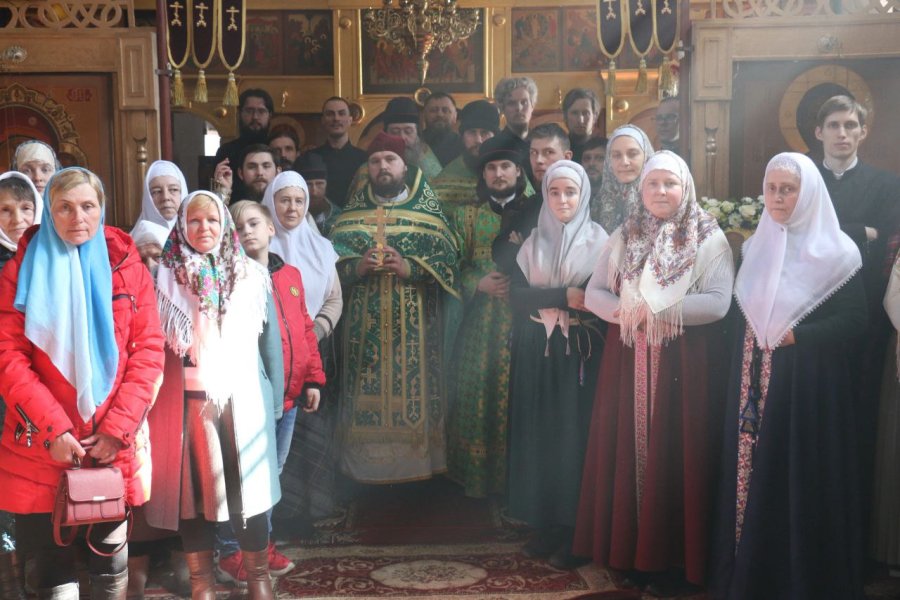
- Good afternoon, father. Can you tell us about such a phenomenon as "Guslitsy Old Believerianism"?
- Good afternoon. Old Believers in Guslitsy have existed for a long time. The population here is autochthonic, that in other words, living in the same area for many centuries. People have not moved from here. In the XX century there was a certain number of "limiters", that is, those who came here from other areas to work in factories, enterprises, and to get a residence permit. But still, these people are visible and noticeable. They are not part of the general structure of the local population, and the locals still identify them as newcomers. The Gusliaks (inhabitants of Guslitsy region) are mostly Old Believers. And these are the Old Believers, who did not accept the Nikon reforms since the XVII century. They have been living here for centuries and keeping their faith.
The peculiarity of Guslitsy is also that, being close to Moscow, there was not such strong persecution in these places, as, for example, in many other Old Believers centers - Vetka, Kerzhenets and others. We know that Old Believers there were driven out of their homes and sent to other places. In Guslitsy, the persecution was about this kind of persecution: imperial police could come to some prayer house, close it, seal it up, and the Old Believers would gather in another one. They would collect some icons, find them, paint new ones... And, in general, this way Old Believers existed here relatively calmly. I even think that many of these closures of these, what was called, schismatic prayer houses in the XIX century were held for the sake of a certain missionary plan. Because there is no other way to explain the fact that here, near the capital, there was such a large center of the Old Believer schismatic movement - and without any serious consequences for themselves.
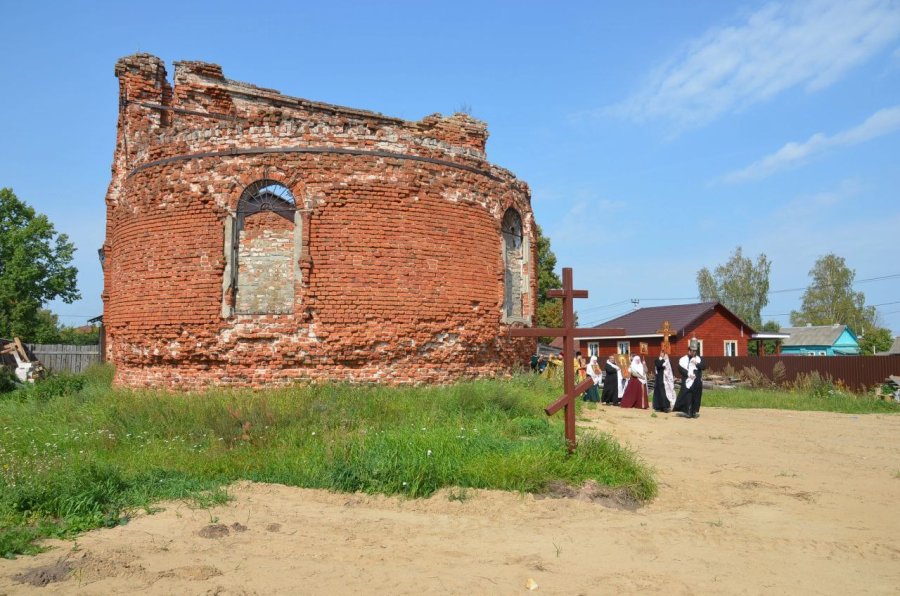
- What was the situation with Edinoverie in these lands?
- As for Edinoverie, in the Guslitsky region it was represented by three parishes: the parish of the Church of the Exaltation of the Holy Cross in the village of Selino-Davydovo, which is near the town of Kurovskoe; the Church of St. Peter the Metropolitan in the village of Avsunino; and the Church of the Nativity of Christ in the village of Malkovo. If the Church of the Exaltation of Christ in Selino-Davydovo and the Church of St. Peter the Metropolitan were built with a missionary purpose, the Church of the Nativity of Christ in Malkovo was built by Old Believers, who themselves converted to Edinoverie, and not under any external influence, but by their own consideration of the foundations of faith. They found patrons, created a community, and built a church. It was, so to say, an initiative from below. It is an interesting precedent, because we know that often in the 19th century Edinoverie communities were created in a completely different way, namely by imposing Edinoverie by a directive from above. Such Edinoverie was created for missionary purposes, for the future. Cases of voluntary transition of the Old Believer community to Edinoverie were very few. But, despite their small number, such communities have always been quite strong. At first, there were many more of them, but the violent nature of the conversion of the Old Believers to Edinoverie under Nicholas I alienated many of them. And as practice has shown, very few of the involuntary communities became conscious Edinoverie believers. Years and generations passed, and when in the early 20th century, according to the decree of Tsar Nicholas II, Old Believers were given freedom, many of these communities, once driven into Edinoverie, began to leave it and to demand the return of the church premises, icons... There were precedents of this kind of government-imposed Edinoverie, but to a lesser extent in Guslitsy. Again, this paradox, when in an Old Believer region, next to the Metropolitan of Moscow's cathedra, no tangible violent methods are introduced.
Here, in Guslitsy, the Brotherhood of Peter the Metropolitan, the most active missionary organization, is founded. Missionary schools are also established here, teaching, however, not missionaries, but children of Old Believers. In addition to the various sciences, they also taught children Edinoverie. That is, the children received free education, and at the same time instruction in the need to be in unity with the Church. It was a rather peaceful realization of the mission - working with children for the future.
And so a church was built at one of these schools in the village of Avsyunino. It, by the way, was visited by the famous Edinoverie missionary Archimandrite Paul (Lednev). And it was his idea to build a school here, so that in the future a church could be formed at it. After the talks that Paul Lednev conducted with the Old Believers in the area, he had the opinion that in the village of Avsyunino, Edinoverie can especially take root, and that it was here at that time, there was a certain fertile ground for it. There Pavel Lednev also met an Old Believer Andrei Stepanov, who later became a Edinoverie priest in the aforementioned village of Malkovo.
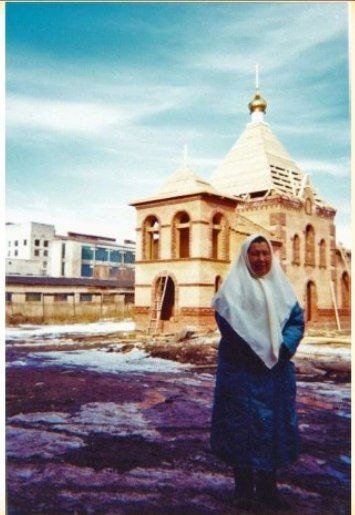
- What happened to these communities during the Soviet period?
- During the Soviet period Edinoverie churches were closed. The Church of the Exaltation in the village of Davydovo was closed and converted into a school gymnasium. The church in Avsunino was used as a clubhouse. Priests of the Church of the Nativity of Christ in Malkovo were repressed. The son of a priest Andrei Stepanov, also a clergyman, was repressed in the 30s. In the 1940s, the church was empty, although there is evidence that local Old Believers and schismatics prayed there during the war. After the war the church was abandoned and used as a grain warehouse. And only with the coming of the 90s, Edinoverie in Guslitsy reached a new frontier.
- Tell us specifically about your parish, when and from whom it was formed?
- Actually, this new frontier of Edinoverie was formed, first of all, thanks to the efforts of an honorable citizen of the Orekhovo-Zuevsky district - Ustinya Andriyanova. This was a small, frail, elderly woman, but how much activity, how much strength and energy was in her! In her native village Stepanovka an old abandoned school was converted into a museum through her efforts. There was an exposition about the history of the Great Patriotic War, about the school itself, about the village Stepanovka, and the Old Believers' way of life. Next to the museum is the Memorial Alley of Glory of Heroes of the Great Patriotic War - those who went to the front from Stepanivka and did not return. In memory of every soldier who did not return from the battlefield, a blue spruce is planted. Ustinya Grigoryevna somehow managed to get these blue spruces in the era of shortages in the mid-1980s. She also brought from Kurovskoe the monument to Heroes sent for recycling and created a memorial of Glory at her place in Stepanovka.
In addition, Ustinya Grigorievna saved the holy spring of the Kazan icon of the Mother of God from destruction between the villages of Stepanovka and Avsunino. At that time, in the 80s, it was believed that this spring attracts too much religious attention, and this attention had to be somehow diverted. Ustinya Grigorievna, as the head of the state farm, was instructed to fill this spring with earth. However, as a religious person, moreover, from hereditary Old Believers, she, on the contrary, managed to defend it. Ustinia Grigorievna was never shy about confessing her faith. For example, at some point she openly married at church, which was quite a rare occurrence for a member of the Communist Party. This steadfastness was especially encouraging and inspired her to do all kinds of things.
Having preserved the spring of the Kazan icon of the Mother of God, in the future Ustinya Grigorievna was able to build a chapel there, so that the spring became a place of pilgrimage for local Christians.
And she lived in Kurovskoe, the only town in Guslitsy. Because Guslitsy is a cluster of villages, and Kurovskoe was a village, which in Soviet times grew at the expense of the factory and became a large population center. However, Kurovskoe district was listed in the Moscow region as an independent one even before the Khrushchev consolidation reform. It was a significant settlement, also due to the hub railway station located here. In Soviet times, life here was boiling...
But in the early 90s, when everything was falling apart and being destroyed, Ustinya Grigorievna decided to arrange an Old Believer church in her town. It must be said that many Old Believer priests at the time had such an attitude: it is better to let them come to me than to create new communities and thus lead people away from me. Such an approach strongly alienated people from Old Belief. Ustinia Grigorievna began to study the question of what kind of Old Believers' confessions existed. And she came to the conclusion that unity with the Russian Orthodox Church on the rights of Edinoverie is the same Old Believerism, and that this would be a worthy way for the Old Believers of Guslitsy. It is worth adding that many here were descendants of the Neokruzhniks (a schism of the Belokrinitsa Old Believers, whose disagreement consisted in their refusal to pray for the tsar - ed.). There were also many Luzhkans (an Old Believer confession, which only accepted runaway clergy from one area, the so-called Luzhki, ed.) and representatives of other priestly movements. The majority, however, were Belokrinitsa Old Believers (i.e., adherents of the Belokrinitsa Hierarchy, now the Russian Orthodox Old Believer Church - Ed.) I occasionally encountered children of Old Believers, but by the early 90s they were already quite elderly.
Ustinia Grigorievna decided to convert to Edinoverie. After uniting the local Old Believers of Guslitsy, she organized a delegation to Mikhailovskaya Sloboda, whereupon Fr. Irinarkh Denisov started coming to Kurovskoe to serve molebens at the local house of culture. According to his testimony, several hundred Old Believers gathered for these services.
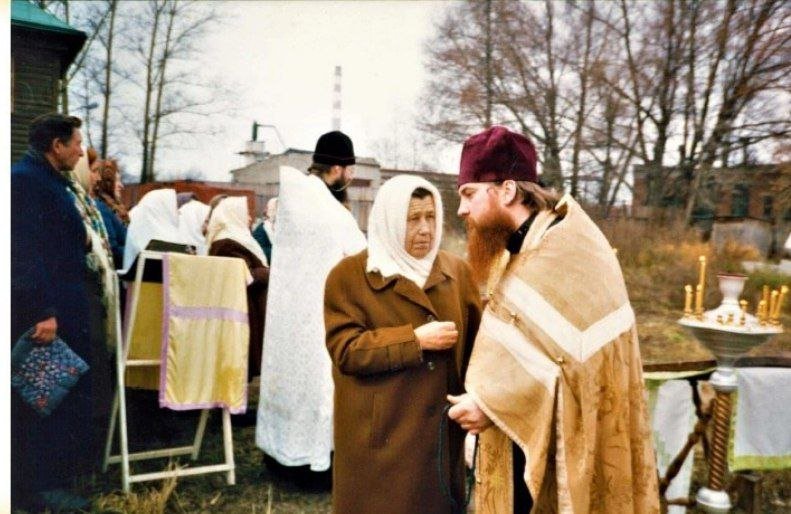
- Who was the first rector of the congregation? What problems did the congregation face?
- The priest Dimitry Kuznetsov was appointed here. On his shoulders fell the task of organizing the Old Believer community in the bosom of the Russian Orthodox Church. Through the efforts of father Dimitry, Ustinia Grigorievna, as well as many parishioners and patrons of the time repaired a house at 87 Sovetskaya St., which was given to the Holy Transfiguration Orthodox Old Believer community of Kurovskoe (such wording was mentioned in the documents of 1994, issued by the local administration). At the same time, the church house was repaired, after which it received the status of a church house.
Prior to that, it was the home of the local merchant Kudryavtsev, an Old Believer, who was repressed in the 30s. During the Soviet time the local NKVD department and the Kurovskoe police were located there. And paradoxically, but through the walls of this house, especially in the 30s, quite a few Old Believer clergy passed to their Golgotha. It is known that prominent Old Believer priests were detained here. For example, the bishop of Rzhev Peter (Glazov), who was one of the leaders of the Neokruzhniki confession, but later, in the 60s, reunified with the Old Believer Church. Also, the local Old Believer priest, Archip Davidovich Azarnov, who laid his head in the same grave as Edinoverie priest-martyr John Borozdin, on September 27, 1937. Many others, such as the local readers who suffered not for their Old Beliefs, but for their confession of faith in Jesus Christ, as the archives of the cases that survived within these walls clearly testify. Or another example: in the case of the destruction of the prayer house in Mistsevo in 1937, a man is accused of simply believing in God. The man professes his faith without seeing any delusion in it, and after a series of interrogations he is subjected to the harshest treatment, up to execution. This is the kind of "house with a history" the parish got, nicknamed "police" by the locals. And when the local congregation came here, they started saying: "Where do you go to pray? - To the police". Some people still refuse to go to pray in this "police" because of its past. But on the other hand, people suffered here for confessing the faith of Christ - so this house and the Church of the Transfiguration adjoining it become, in essence, the Church of the Savior on the Blood.
In 1999, the wooden annex to the church house underwent some reconstruction, and the Church of the Transfiguration began to work there. At this time, a stone, single-domed temple in honor of the venerable John of the Ladder, is built. Why the venerable John? Because the most money for the construction of this church was donated by local businessman and philanthropist Komissarov Ivan Timofeevich in memory of his patron saint. Quite a rare church saint, especially for Edinoverie.
But the consecration of a wooden church in honor of the Transfiguration of the Lord is connected with the fact that in this area - in the town of Kurovskoe, in the village of Zavolny and in other neighboring villages - it is a feast day.
There is a legend that during the time of the Tatar-Mongol yoke in these places at the Nerskaya River, passing just through Kurovskoe, Saint Photius of Moscow was saved from the Tatars who seized Moscow. The saint drowned, but miraculously he came ashore and thereafter he erected here on the bank of the river the Church of the Transfiguration. Since that time both the city of Kurovskoe itself, and the nearby settlements have been dedicated to this feast. According to other legends not only St. Photius, but also St. Kiprian, Metropolitan of Moscow also was saved in the local forests of Guslitsy... One way or another, but Transfiguration has been venerated here from the earliest times, and in the city of Kurovskoe, in addition to the Edinoverie community of the Transfiguration of the Saviour, there is also the Guslitskiy monastery, founded by Archimandrite Parfeniy in the XIX century and formerly one of the local missionary centers. In 2000, the church of St. John of the Ladder was consecrated according to the Old Russian rite by bishop Tikhon of Vidnoye by the blessing of Metropolitan Juvenaly of Krutets and Kolomna. Father Dimitriy, the rector of the church, concelebrated with a group of clergy of Edinoverie represented by hegumen Peter Vasilyev, priest Sergiy Pshenok, priest Leontiy Kolnogorov and many others. Parishioners of various Edinoverie communities of Moscow and the Moscow Region prayed together. Eyewitnesses of that consecration said that the temple was so full that people were standing even outside. They say that the wooden church - even before the consecration of the stone temple - was so full that during the polyeleos, people were afraid to burn one another from the candles they held in their hands, and that it was impossible even to make a ground prostration - so close were all standing to one another. All this suggests that the city of Kurovskoe at that time had a great potential to become one of the modern centers of Edinoverie. In fact, it did become one.
From 1994 to 2016, the Holy Transfiguration Edinoverie community in Kurovskoe was headed by priest Dimitry Kuznetsov. But due to various circumstances, including difficult relations with the local clergy, as well as the untimely death of Ustinia Grigorievna Andrianova, the founder of the Edinoverie community and a longtime assistant to the father rector, it so happened that priest Dimitriy, if I may say so, to some extent fell into despair. At a certain point, the Moscow diocesan administration decided to transfer him off the staff, allowing him to conduct services in the community of the Transfiguration of the Savior by agreement with the new rector.
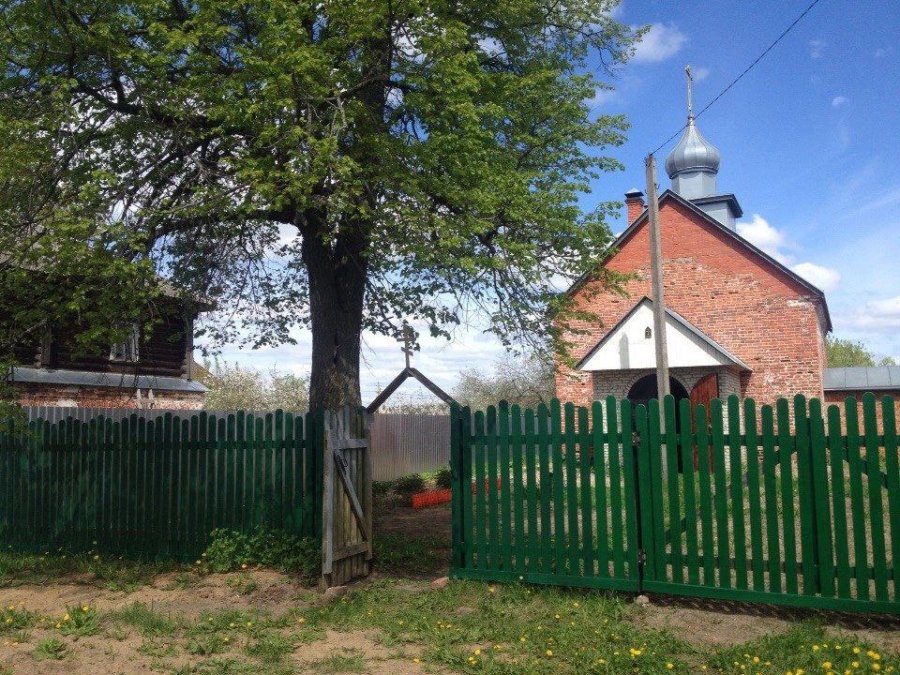
- Who became rector after Father Dimitry Kuznetsov?
- In February 2016, hieromonk Anthony (Anenko) became rector of the Transfiguration Edinoverie community in the city of Kurovskoe. A new page in the life of the community opens. A long overdue reconstruction of the Church of the Transfiguration of the Savior begins. A fungus was found in the wooden church, that caused the floors to break down. After that the church became unsuitable for services.
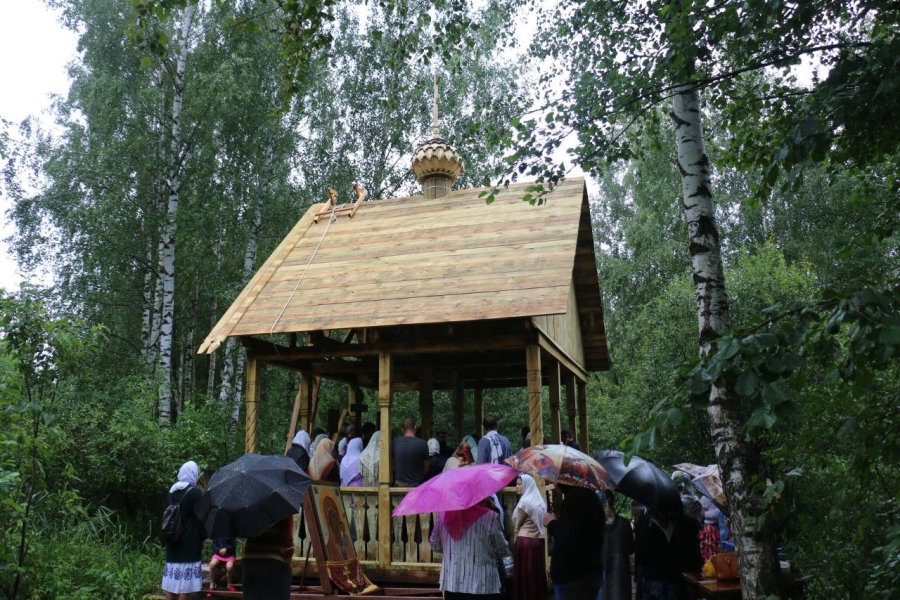
- What else happened during your term of service here?
- In 2016, the wooden Church of the Transfiguration was raised to a higher foundation, vents were made, the lower venues were rebuilt, a new floor was laid, load-bearing ceilings were installed, and wooden columns supporting the ceiling were installed. In the Church of St. John of the Ladder, cosmetic repairs were made with painting of the walls and renovation of the icons and icon cases. In July 2016 a second clergyman, priest Alexey Guglivaty, was ordained for the Transfiguration of the Savior community in Kurovskoe. At the same time, in July 2016, Edinovertsy of the village of Avsyunino, who had been there since the time of their priest Dimitriy Kuznetsov, received the church of St. Peter, Metropolitan of Kiev. Priest Alexei Guglivaty was appointed rector of the church. The church was registered as Edinoverie, and its restoration began. In 2017, with the blessing of Metropolitan Juvenaly of Krutets and Kolomna, archpriest Andrei Korobkov of the Orekhovo-Zuevsky church district was entrusted to lead the patronage of local parishes in the restoration of the Church of Peter the Metropolitan. From 2017 to 2021 in the refectory of the church extensive repairs were carried out. Now it is already possible to perform Divine Liturgy there. The church is warm and heated. It is almost impossible to recognize in it what was received in 2016. A lot of different work has been done. In 2020, again with the blessing of Metropolitan Juvenaly of Krutets and Kolomna, a narthex was established for the church of Peter the Metropolitan in honor of the Nativity of the Blessed Virgin Mary, one of the patronal feasts of Avsunino village. In 2021 an antimins was consecrated for the new chapel, and the first Divine Liturgy in the church was celebrated on the Feast of the Transfer of the Relics of St. Peter the Metropolitan. Returning to the Transfiguration community of Kurovskoe, it should be said that in December 2017, by decree of Metropolitan Juvenaly of Krutets and Kolomna, priest-hierarch Alexei Guglivaty became its rector.
In 2018 we held the first procession from the Church of Peter the Metropolitan in the village of Avsyunino to the holy spring of the Kazan icon of the Mother of God. In previous years, in Avsyunino, back under father Dimitriy, on the feast of Our Lady of Kazan on July 21, there was a tradition to bless the waters of the spring. However, at the time of 2018, the holy spring was in an extremely poor condition: the canopy made under Ustinya Grigoryevna Andriyanova had collapsed, and the platform from which people drew water had rotted away. After our first procession, one of our parishioners, Igor Borisovich Golubev, undertook a rather amazing feat. From the fall of 2018 to the summer of 2019, he was preparing lumber to restore the spring of Our Lady of Kazan and build a chapel on it. And from the spring to the summer of 2019 he put a chapel of amazing beauty on the spring in the style of ancient Russian wooden architecture. With a dome, with plowshares... It was a very big celebration for us. In 2019, we walked in procession already to the new chapel and with special reverence. Then there was a solemn service of thanksgiving to God and our helper, Igor Borisovich Golubev. We were very encouraged that in our time such miracles are happening.
It is worth saying that the procession to the spring of the Kazan icon of the Mother of God we did not abandon even in the "pandemic" years of 2020 and 2021. God willing, we will do new ones in 2022-2023. On the Feast of the Pentecost we also consecrate water at the spring.
In 2019 a film was made about Ustinia Grigorievna Andriyanova. It was filmed by a team of Orthodox journalists from Rostov-on-Don. I would like to express special thanks to Apollinaria Chestnikova for shooting this film. She really helped us a lot: she took on this project and worked on everything in it down to the smallest detail. As a result, the film turned out wonderful and became a tribute to an honorary citizen of Orekhovo-Zuevsky area Ustinya Grigorievna Andriyanova, the founder of the Transfiguration community of Edinoverie in the town of Kurovskoe.
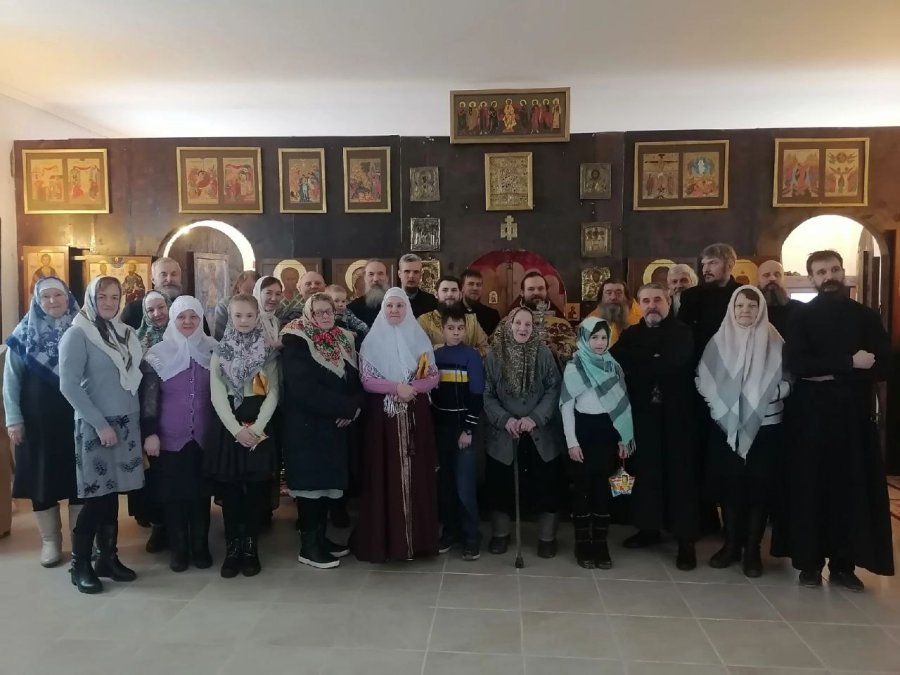
- What is the congregational and liturgical life in your parishes like now?
- At present, services at the Holy Transfiguration Edinoverie congregation are being held on a regular basis. The parishioners do their own schedule of daily watch: they take care of the church and its territory. They also actively participate in congregational life, take part in clean-up days, and are especially zealous for the worship service. Our choir now has new chanters and readers, which is great. Thank God, young people and children are also coming. This cannot help but please us and gives us hope that our work lives and, God willing, will live on. The community is slowly growing, although it is still small. But we are not discouraged and treat all the members of our communities in Kurovskoe, Avsunino, Mistsevo as our relatives and neighbors, as our family. Together we try to do everything to glorify our Lord and Savior Jesus Christ and to save and call to salvation the souls of people of good will.
Of what we have done over the years, we can also note the following. In the village of Mistsevo, we are preparing to renovate the chapel. In 2018 we installed an iconostasis there. It is printed, but it is good because, on the one hand, it is silkscreen, that is, not quite a simple print, and on the other hand, it is an iconostasis that stylistically is more disposed to prayer and prayerful contemplation. In addition, since the climatic conditions in the Mistsevo chapel are now quite unstable, it is better to have an iconostasis made of more durable and long-lasting materials. And painted icons, especially if they are old, unfortunately, quickly deteriorate there. This is a fact. God willing, we will spend a little repair there to improve the climate and extend the life of the icons.
In the village of Mistsevo, in general, there are many interesting places associated with the history of Old Believers. In particular, there is a nearby cemetery of Old Believer monks, who lived in the hermitages of Mistsevo forest since the XVIII century. We found this cemetery in the winter of 2017 with a fellow believer from Moscow, Evgeny Yuferev, in a rather decadent condition: completely overgrown and with two rotted crosses. Then we called on local residents, and they took part in the restoration of this cemetery. The young sprouts of trees were cut down and three crosses and a memorial cross were placed. And in 2021, Igor Borisovich Golubev installed a hand-carved golbets, gates and signs leading to this revered place. Locals have long considered it holy, and called it "father's graves". We will add that it is a real object of religious and cultural heritage!
So that's the outline of our being in the Old Believers' land of Guslitsy.


